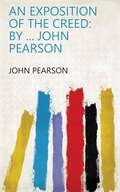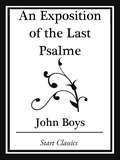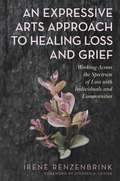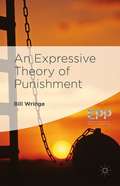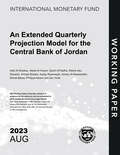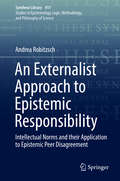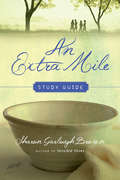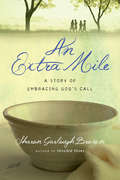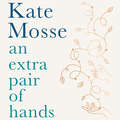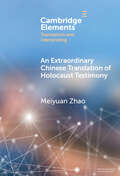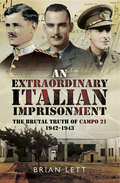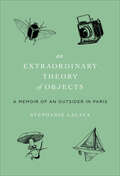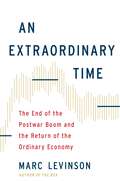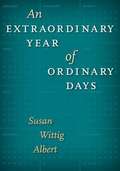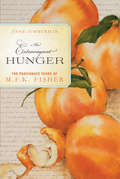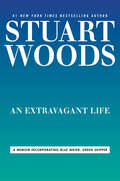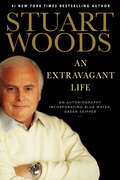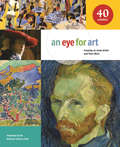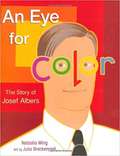- Table View
- List View
An Explorer's Notebook: Essays on Life, History, and Climate
by Tim FlanneryBest known today for The Weather Makers, his #1 international bestseller, Tim Flannery is one of the world’s most influential scientists, a foremost expert on climate change credited with discovering more species than Charles Darwin. But Flannery didn’t come to his knowledge overnight. With its selection of exhilarating essays and articles written over the past 25 years, An Explorer’s Notebook charts the evolution of a young scientist doing fieldwork in remote locations to the major thinker who has changed the way we think about global warming.In over thirty pieces, Flannery writes about his journeys in the jungles of New Guinea and Indonesia, about the extraordinary people he met and the species he discovered. He writes about matters as wide-ranging as love, insects, population, water and the stresses we put on the environment. He shows us how we can better predict our future by understanding the profound history of life on Earth. And he chronicles the seismic shift in the world’s attitude toward climate change. An Explorer’s Notebook is classic Flannery-wide-ranging, eye-opening science, conveyed with richly detailed storytelling."Tim Flannery is in the league of all-time great explorers like Dr. David Livingstone.”-Sir David Attenborough
An Exposition Of The Creed
by John Pearson Temple ChevallierThis is a reproduction of a classic text optimised for kindle devices. We have endeavoured to create this version as close to the original artefact as possible. Although occasionally there may be certain imperfections with these old texts, we believe they deserve to be made available for future generations to enjoy.
An Exposition of Hebrews
by Arthur W. PinkAn Exposition of Hebrews is the most complete and thorough study ever written on the subject. This books spends close to six hundred thousand words looking at every nuance and implication of the book of Hebrews. A wonderful tool for pastors, students, or anyone wishing a deeper understanding of this important book from the bible. Originally pushed as a series of articles and then as a two volume set, you can now have the entire unabridged edition of this book in one affordable volume.
An Exposition of the Last Psalme (Start Classics)
by John Boys"An Exposition of the Last Psalme", published in 1613, was delievered as a sermon by John Boys.
An Expressive Arts Approach to Healing Loss and Grief: Working Across the Spectrum of Loss with Individuals and Communities
by Irene RenzenbrinkDrawing on expertise in both expressive arts and grief counselling, this book highlights the use of expressive arts therapeutic methods in confronting and healing grief and bereavement. Establishing a link between these two approaches, it widens our understanding of loss and grief.With personal and professional insight, Renzenbrink illuminates the healing and restorative power of creative arts therapies, as well as addressing the impact of communion with others and the role that expressive arts can play in community change. Covering a broad understanding of grief, the discussion incorporates migration and losing one's home, chronic illness and natural disasters, highlighting the breadth of types of loss and widening our perceptions of this. Grief specialists are given imaginative and nourishing tools to incorporate into their practice and better support their clients.An invaluable resource to expand understanding of grief and explore the power of expressive arts to heal both communities and individuals.
An Expressive Theory of Punishment (Palgrave Studies In Ethics And Public Policy Ser.)
by Bill WringeAn Extended Quarterly Projection Model for the Central Bank of Jordan (Imf Working Papers)
by VlcekA report from the International Monetary Fund.
An Extended Quarterly Projection Model: Credit Cycle, Macrofinancial Linkages and Macroprudential Measures: The Case of the Philippines (Imf Working Papers)
by Philippe Karam, Mikhail Pranovich and Jan VlcekA report from the International Monetary Fund.
An Externalist Approach to Epistemic Responsibility: Intellectual Norms and their Application to Epistemic Peer Disagreement (Synthese Library #411)
by Andrea RobitzschThis monograph provides a novel reliabilist approach to epistemic responsibility assessment. The author presents unique arguments for the epistemic significance of belief-influencing actions and omissions. She grounds her proposal in indirect doxastic control.The book consists of four chapters. The first two chapters look at the different ways in which an agent might control the revision, retention, or rejection of her beliefs. They provide a systematic overview of the different approaches to doxastic control and contain a thorough study of reasons-responsive approaches to direct and indirect doxastic control.The third chapter provides a reliabilist approach to epistemic responsibility assessment which is based on indirect doxastic control.In the fourth chapter, the author examines epistemic peer disagreement and applies her reliabilist approach to epistemic responsibility assessment to this debate. She argues that the epistemic significance of peer disagreement does not only rely on the way in which an agent should revise her belief in the face of disagreement, it also relies on the way in which an agent should act.This book deals with questions of meliorative epistemology in general and with questions concerning doxastic responsibility and epistemic responsibility assessment in particular. It will appeal to graduate students and researchers with an interest in epistemology.
An Extra Mile Study Guide: A Story Of Embracing God's Call (Sensible Shoes Series)
by Sharon Garlough BrownWhat next steps is God calling you to take? Join the characters of An Extra Mile, the final book in the Sensible Shoes series, as they journey through the seasons of Lent and Easter. In this eight-week study guide you'll dive deeper into key spiritual practices from the book, using daily Scripture readings and reflection questions designed to help you be attentive to the invitations of the Holy Spirit. Each week concludes with discussion questions and suggested practices for groups to do together. This guide offers the perfect tools for individuals and groups to explore and apply the spiritual formation themes of An Extra Mile along with Mara, Hannah, Charissa, and Becca.
An Extra Mile: A Story of Embracing God's Call (Sensible Shoes Series)
by Sharon Garlough BrownSensible ShoesMara:Hannah:Charissa:Becca:
An Extra Pair of Hands
by Kate MosseA deeply moving story of what it means to care for those we love by bestselling author Kate Mosse, a celebration of older people and ageing, and of finding joy in the smallest acts of everyday caregiving.As our population ages, more and more of us find ourselves caring for parents and loved ones - some 8.8 million people in the UK. An invisible army of carers holding families together.Here, Kate Mosse tells her own personal story of finding herself a carer in middle age: first, helping her heroic mother care for her beloved father through Parkinsons, then supporting her mother in widowhood, and finally as 'an extra pair of hands' for her 90- year-old mother-in-law.This is a story about the gentle heroism of our carers, about small everyday acts of tenderness, and finding joy in times of crisis. It's about juggling priorities, mindnumbing repetition, about guilt and powerlessness, about grief, and the solace of nature when we're exhausted or at a loss. It is also about celebrating older people, about learning to live differently - and think differently about ageing.But most of all, it's a story about love.
An Extraordinary Chinese Translation of Holocaust Testimony (Elements in Translation and Interpreting)
by Meiyuan ZhaoThis Element focuses on two Holocaust testimonies translated into Chinese by translator, Gao Shan. They deserve attention for the highly unorthodox approach Gao adopted and the substantial alterations he made to the original texts. The study begins by narrating the circumstances that led to these translations, then goes on to explore Gao's views on translation, his style, additions to the original accounts, and the affective dynamics of his translation activity. The author draws on concepts from sociology, memory studies, and sociolinguistics to frame the discussion and highlight the ethical concerns inevitably involved in Gao's work. Without minimizing the moral responsibility of faithful transmission that Holocaust material should always impose, the author wants to show how Gao sometimes sacrifices strict accuracy in his desire to make the survivors' experiences intelligible to a prospective audience wholly unacquainted with the Holocaust.
An Extraordinary Italian Imprisonment: The Brutal Truth of Campo 21, 1942–3
by Brian LettThis book tells the story of prisoner of war camp PG 21, at Chieti, Italy, between August 1942 and September 1943. It was grossly overcrowded, with little running water, no proper sanitation, and in winter no heating.Conditions (food/clothing) for POWs were so bad that they were debated in the House of Commons.The prisoners suffered under a violently pro-Fascist regime. The first Commandant personally beat up one recaptured escaper. A pilot was murdered by an Italian guard following his escape attempt. Tunnels were dug, and the prisoners were even prepared to swim through human sewage to try and get out. Morale in the camp remained remarkably high. Two England cricket internationals staged a full scale cricket match. Theatre and music also thrived.After the Italian Armistice, in September 1943, the British Commander refused to allow the ex-prisoners to leave camp. Germans took over the camp, and most prisoners were transported to Germany. Some managed to hide, and more than half of these subsequently escaped. After the war, a number of the Camp staff were arrested for war crimes.
An Extraordinary Ordinary Woman: The Journal of Phebe Orvis, 1820-1830 (Excelsior Editions)
by Susan M. OuelletteIn 1820, Phebe Orvis began a journal that she faithfully kept for a decade. Richly detailed, her diary captures not only the everyday life of an ordinary woman in early nineteenth-century Vermont and New York, but also the unusual happenings of her family, neighborhood, and beyond. The journal entries trace Orvis's transition from single life to marriage and motherhood, including her time at the Middlebury Female Seminary and her observations about the changing social and economic environment of the period. A Quaker, Orvis also recorded the details of the waxing passion of the Second Great Awakening in the people around her, as well as the conflict the fervor caused within her own family.In the first section of the book, Susan M. Ouellette includes a series of essays that illuminate Orvis's diary entries and broaden the social landscape she inhabited. These essays focus on Orvis and, more importantly, the experience of ordinary people as they navigated the new nation, the new century, and the emerging American society and culture. The second section is a transcript of the original journal. This combination of analytical essays and primary source material offers readers a unique perspective of domestic life in northern New England as well as upstate New York in the early nineteenth century.
An Extraordinary Theory of Objects: A Memoir of an Outsider in Paris
by Stephanie LaCavaA haunting and moving collection of original narratives that reveals an expatriate's coming-of-age in Paris and the magic she finds in ordinary objectsAn awkward, curious girl growing up in a foreign country, Stephanie LaCava finds solace and security in strange yet beautiful objects.When her father's mysterious job transports her and her family to the quaint Parisian suburb of Le Vésinet, everything changes for the young American. Stephanie sets out to explore her new surroundings and to make friends at her unconventional international school, but her curiosity soon gives way to feelings of anxiety and a deep depression.In her darkest moments, Stephanie learns to filter the world through her peculiar lens, discovering the uncommon, uncelebrated beauty in what she finds. Encouraged by her father through trips to museums and scavenger hunts at antique shows, she traces an interconnected web of narratives of long-ago outsiders, and of objects historical and natural, that ultimately help her survive.A series of illustrated essays that unfolds in cinematic fashion, An Extraordinary Theory of Objects offers a universal lesson—to harness the power of creativity to cope with loneliness, sadness, and disappointment to find wonder in the uncertainty of the future.
An Extraordinary Time: The End of the Postwar Boom and the Return of the Ordinary Economy
by Marc LevinsonThe decades after World War II were a golden age across much of the world. It was a time of economic miracles, an era when steady jobs were easy to find and families could see their living standards improving year after year. And then, around 1973, the good times vanished. The world economy slumped badly, then settled into the slow, erratic growth that had been the norm before the war. The result was an era of anxiety, uncertainty, and political extremism that we are still grappling with today.In An Extraordinary Time, acclaimed economic historian Marc Levinson describes how the end of the postwar boom reverberated throughout the global economy, bringing energy shortages, financial crises, soaring unemployment, and a gnawing sense of insecurity. Politicians, suddenly unable to deliver the prosperity of years past, railed haplessly against currency speculators, oil sheikhs, and other forces they could not control. From Sweden to Southern California, citizens grew suspicious of their newly ineffective governments and rebelled against the high taxes needed to support social welfare programs enacted when coffers were flush.Almost everywhere, the pendulum swung to the right, bringing politicians like Margaret Thatcher and Ronald Reagan to power. But their promise that deregulation, privatization, lower tax rates, and smaller government would restore economic security and robust growth proved unfounded. Although the guiding hand of the state could no longer deliver the steady economic performance the public had come to expect, free-market policies were equally unable to do so. The golden age would not come back again.A sweeping reappraisal of the last sixty years of world history, An Extraordinary Time forces us to come to terms with how little control we actually have over the economy.
An Extraordinary Year Of Ordinary Days
by Susan Wittig AlbertFrom Eudora Welty's memoir of childhood to May Sarton's reflections on her seventieth year, writers' journals offer an irresistible opportunity to join a creative thinker in musing on the events-whether in daily life or on a global scale-that shape our lives. In An Extraordinary Year of Ordinary Days, best-selling mystery novelist Susan Wittig Albert invites us to revisit one of the most tumultuous years in recent memory, 2008, through the lens of 365 ordinary days in which her reading, writing, and thinking about issues in the wider world-from wars and economic recession to climate change-caused her to reconsider and reshape daily practices in her personal life. Albert's journal provides an engaging account of how the business of being a successful working writer blends with her rural life in the Texas Hill Country and the Sangre de Cristo Mountains of New Mexico. As her eclectic daily reading ranges across topics from economics, food production, and oil and energy policy to poetry, place, and the writing life, Albert becomes increasingly concerned about the natural world and the threats facing it, especially climate change and resource depletion. Asking herself, "What does it mean? And what ought I do about it?", she determines practical steps to take, such as growing more food in her garden, and also helps us as readers make sense of these issues and consider what our own responses might be.
An Extravagant Hunger: The Passionate Years of M. F. K. Fisher
by Anne ZimmermanIn An Extravagant Hunger, time slows and is relished, and the turning points and casual strolls of M.F.K. Fisher's life are unwrapped and savored. From the Berengaria that washed her across the sea to France in 1929, to Le Paquis, the Swiss estate that later provided a backdrop for some of the most idyllic and fleeting moments of her life, the stories of Fisher's love for food and her love for family and men are meticulously researched and exquisitely captured in this book. Exploring Fisher's lonely and formative time in Europe with her first husband; her subsequent divorce and re-marriage to her creative sparkplug, Dillwyn Parrish, and his tragic suicide; and the child she carried from an unnamed father, the story of M.F.K. Fisher's life becomes as vibrant and passionate as her prolific words on wine and cuisine.Letters and journal entries piece together a dramatic life, but An Extravagant Hunger steps further, bridging the gaps between personal notes and her public persona, filling in the silences by offering an engaging and unprecedented depth of intuitive commentary. With a passion of her own, Anne Zimmerman is the careful witness, lingering beside M.F.K. Fisher through her most dramatic and productive years.
An Extravagant Life: An Autobiography Incorporating Blue Water, Green Skipper
by Stuart WoodsThe #1 New York Times bestselling author of the Stone Barrington series tells the story of his own life from childhood to the present, and chronicles the journey that made him the writer he is today.Over the last forty years, Stuart Woods has written more than ninety novels of suspense and intrigue, beginning with the award-winning Chiefs. Featuring iconic crime-fighting and jet-setting leads, the plots are masterfully conceived and wonderfully escapist. What many readers don&’t know is that Woods's very own life was filled with similar stories of adventure. Born in Georgia, Woods worked in advertising in New York, served in the US Air Force, and had a short stint as an advance man. At the age of 37, he found himself in a transatlantic sailing race, and pursued writing as a full-time career shortly thereafter. Along the way, Woods has lived all over the world, from New York to London, Santa Fe to Ireland. Incorporating his iconic sailing memoir Blue Water, Green Skipper, this is the story of a life well-lived, and a special inside look into the beloved author&’s many exploits.
An Extravagant Life: An Autobiography Incorporating Blue Water, Green Skipper
by Stuart WoodsThe #1 New York Times bestselling author of the Stone Barrington series tells the story of his own life from childhood to the present, and chronicles the journey that made him the writer he is today.Over the last forty years, Stuart Woods has written more than ninety novels of suspense and intrigue, beginning with the award-winning Chiefs. Featuring iconic crime-fighting and jet-setting leads, the plots are masterfully conceived and wonderfully escapist. What many readers don&’t know is that Woods's very own life was filled with similar stories of adventure. Born in Georgia, Woods worked in advertising in New York, served in the US Air Force, and had a short stint as an advance man. At the age of 37, he found himself in a transatlantic sailing race, and pursued writing as a full-time career shortly thereafter. Along the way, Woods has lived all over the world, from New York to London, Santa Fe to Ireland. Incorporating his iconic sailing memoir Blue Water, Green Skipper, this is the story of a life well-lived, and a special inside look into the beloved author&’s many exploits.
An Eye For The Tropics: Tourism, Photography, and Framing the Caribbean Picturesque
by Krista A. ThompsonImages of Jamaica and the Bahamas as tropical paradises full of palm trees, white sandy beaches, and inviting warm water seem timeless. Surprisingly, the origins of those images can be traced back to the roots of the islands' tourism industry in the 1880s. As Krista A. Thompson explains, in the late nineteenth century, tourism promoters, backed by British colonial administrators, began to market Jamaica and the Bahamas as picturesque "tropical" paradises. They hired photographers and artists to create carefully crafted representations, which then circulated internationally via postcards and illustrated guides and lectures. Illustrated with more than one hundred images, including many in color, An Eye for the Tropics is a nuanced evaluation of the aesthetics of the "tropicalizing images" and their effects on Jamaica and the Bahamas. Thompson describes how representations created to project an image to the outside world altered everyday life on the islands. Hoteliers imported tropical plants to make the islands look more like the images. Many prominent tourist-oriented spaces, including hotels and famous beaches, became off-limits to the islands' black populations, who were encouraged to act like the disciplined, loyal colonial subjects depicted in the pictures. Analyzing the work of specific photographers and artists who created tropical representations of Jamaica and the Bahamas between the 1880s and the 1930s, Thompson shows how their images differ from the English picturesque landscape tradition. Turning to the present, she examines how tropicalizing images are deconstructed in works by contemporary artists--including Christopher Cozier, David Bailey, and Irne Shaw--at the same time that they remain a staple of postcolonial governments' vigorous efforts to attract tourists.
An Eye at the Top of the World: The Terrifying Legacy of the Cold War's Most Daring CIA Operation
by Pete TakedaAt some point during the inhumanly cold Himalayan winter straddling 1965 and 1966, a peculiar collection of box-shaped objects -- one sprouting a six-foot, insect-like antenna -- plummets nine thousand feet down the sheer flanks of a remote peak. Ripped from its moorings by an avalanche, the jumbled apparatus slides down a funnel-shaped hourglass of hard snow and shoots over a black cliff band, careening a vertical distance six times the height of the Empire State building. The boxes come to rest on the glacier at the mountain's base. One, an olive-drab casing the size of a personal computer, begins to sink. Then, trailing a robotic dogtail of torn wires, it slowly burns through the snow, melting into solid blue glacial ice, eventually disappearing beneath the surface, and never seen again. No one actually witnessed this event. But as you read these words, nearly four pounds of plutonium -- locked in the glacier's dark unknowable heart -- are almost certainly moving ever closer to the source of the Ganges River. Eye at the Top of the World, provides a harrowing present-day account of Takeda's expedition to solve the mystery of Nanda Devi.
An Eye for Art: Focusing on Great Artists and Their Work
by National Gallery of ArtLavishly illustrated with hundreds of full-color images, this family-oriented art resource introduces children to more than 50 great artists and their work, with corresponding activities and explorations that inspire artistic development, focused looking, and creative writing. This treasure trove of artwork from the National Gallery of Art includes, among others, works by Raphael, Rembrandt, Georgia O'Keeffe, Henri Matisse, Chuck Close, Jacob Lawrence, Pablo Picasso, and Alexander Calder, representing a wide range of artistic styles and techniques. Written by museum educators with decades of hands-on experience in both art-making activities and making art relatable to children, the activities include sculpting a clay figure inspired by Edgar Degas; drawing an object from touch alone, inspired by Joan Miro's experience as an art student; painting a double-sided portrait with one side reflecting physical traits and the other side personality traits, inspired by Leonardo da Vinci's Ginevra de' Benci; and creating a story based on a Mary Cassatt painting. Educators, homeschoolers, and families alike will find their creativity sparked by this art extravaganza.
An Eye for Color: The Story of Josef Albers
by Natasha Wing Julia Breckenreid<p>As a child, Josef Albers loved to watch his handyman father paint houses.When Josef grew up and became an artist, he reduced each image to its simplest shapes, breaking it down into blocks of color. <p>He made an incredible discovery: he could alter the entire mood of a painting just by changing the way he combined the colors! Josef spent his entire life studying color, and what he found revolutionized the way people look at art.</p>

